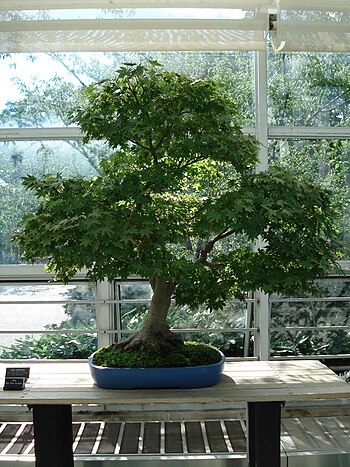 |
| A Seiju elm (Ulmus parvifolia 'Seiju') bonsai display on display at the 2009 annual show of The Bonsai Society of Greater Hartford. The display includes a number of elements of traditional bonsai presentation: the tree is in a ceramic pot on a decorative wooden table, and the display area includes a shitakusa (companion planting) of miniature hosta and a kakemono (hanging scroll). (Photo credit: Wikipedia) |
We all know about the basic Bonsai gardening, but that's just the beginning. To really own a masterpiece Bonsai, one must require good styling skills. Styling in Bonsai trees can be broadly categorized according to the number of trunks the tree has. This can be divided into a single trunk and multiple trunks.
Single trunk styling
The single trunk styling in Bonsai can be further classified into four types namely, Formal upright, Slanting, Cascade, and Twisted style.
Formal upright bonsai gardening
The formal upright style is also called the Chokkan style. This style is adopted only by experienced Bonsai artists. If you are a beginner you are advised not to go for this style. The Chokkan style is considered the most complex style of Bonsai trees. Tachiki, Hokidachi, Sabamiki, Saramiki, Sekijoju, Ishitsuki, and Nagari are some of the subcategories in the Chokkan style.
Bonsai gardening style for beginners
The slanting style called the Shakan style is more common for beginners to use. In the slanting style, all the branches can come to one side of the trunk (windswept style) or a few branches will come out of the top while the main trunk is long.
 |
| Cascade style conifer (Photo credit: Wikipedia) |
Cascade style of Bonsai gardening
The Cascade style or the Kengai style has the bottom trunk below the pot. The other trunks are formal upright. Two subcategories called the Formal cascade and the Semi cascade are available in this type. These are also called the Dai Kengai and the Han Kengai.
Twisted style of Bonsai Gardening
The twisted style is called the Bankan style, which is a favorite of the Chinese. This style is referred to as the dragon style, as the tree coils itself like a dragon. Subcategories to this style include partially twisted and the octopus style (where the branches twist around themselves).
Multiple trunks style
The multiple trunks style simply means this Bonsai has multiple plants in the same pot. The styles in these types include Soju style, Yose style, and the Korabuki style.
Soju style
with Soja style, there are two trunks in a pot.
Yose style
Bonsais With more than two trunks are categorized as the Yose style. The Yose style also varies depending on the number of trunks that are available in the pot. 3, 5, 7, and 9 trunks are called, Sambon Yose, Gohon yose, Nanahon yose, and Kyuhon yose respectively.
Korabuki style
There are styles where the different trunks arise from a single root. A style called the Korabuki style is also a part of the multi-trunk category. The style looks very different in that it looks as if the tree has fallen down and the branches of the tree look like individual trees.
Whatever be the style of your bonsai gardening it is necessary to maintain them properly with professional care.
Permanent Link: https://www.isnare.com/?aid=42304&ca=Gardening |











